|
Get AfricaFocus Bulletin by e-mail!
Format for print or mobile
Southern Africa/Global: Cyclone Idai and Climate Justice
AfricaFocus Bulletin
March 22, 2019 (190322)
(Reposted from sources cited below)
Editor's Note
A week after Cyclone Idai struck the coast of Mozambique near
Beira, there are still people awaiting rescue from treetops and
roofs. The death toll, with confirmed deaths numbering in the
high hundreds, is still unknown, with the largest number in Mozambique,
and still devastating numbers in Zimbabwe and Malawi as well. The
full impact has been slow to emerge, but it is finally gaining more
attention from world media.
This AfricaFocus Bulletin contains excerpts and links under three
topics: strategic ways to contribute, sources for updates, and the
issue of climate change and climate justice.
For quick overviews of the situation, check out these short
videos.
Guardian, March 19, 2019 – 2-minute video overview
https://www.youtube.com/watch?v=rCO9MSRXYWA
ENCA, Rescue operations in Buzi, Mozambique, March 20, 2019 – 3-
minute video
https://www.youtube.com/watch?v=nIM-MBR6yNk
Deutsche Welle, March 20, 2019 – 5-minute video
https://www.youtube.com/watch?v=9S5RlM7KGZI
For previous AfricaFocus Bulletins on climate change and the
environment, visit http://www.africafocus.org/intro-env.php
For extensive ongoing updates, see
https://clubofmozambique.com/ and
https://reliefweb.int/disaster/tc-2019-000021-moz
++++++++++++++++++++++end editor's note+++++++++++++++++
|
Strategic ways to contribute
This list is selective and far from complete. If you know an
international relief organization that you trust, it is likely
that they are there by now. And, if you have contacts with other
organizations working on the ground, you may want to use those
channels. These are a few strategic suggestions, taking into
account the ongoing need to strengthen organizations that dealing
not only with the immediate crisis but with recovery and
preparation for the next crises.
The United Nations has an essential role in response to
emergencies. Its coordinating body for this is UNOCHA.
To contribute for Cyclone Idai in Mozambique, Zimbabwe, and Malawi
go to http://tinyurl.com/y4gnjr5j
You can also donate through a 5 times match to UNICEF
(through May 10) at http://tinyurl.com/y3lrr7za
Doctors without Borders, as is often the case, was one of the
first international agencies on the ground in Beira. To contribute
for Cyclone Idai go to http://tinyurl.com/y2a76wdb
Health Alliance International has been working in Mozambique, with
the Ministry of Health for over 30 years, and has staff in Beira.
Contribute at https://healthallianceinternational.org/cyclone-idai/
The Mozambican organization Alternactiva has launched a
crowdfunding campaign, in partnership with Mozambique Peasants
Union (UNAC) and Forum Mulher, with a particular focus on
supporting recovery by peasants and women in Sofala province.
Contribute at http://tinyurl.com/y3angh75
Unidos por Beira
https://www.facebook.com/unidosporbeira/
A group of volunteers in Maputo, who as of yesterday had
coordinated collection of goods for Beira and packed them into
containers (approximately 700 tons) that will depart for Beira by
ship tomorrow.
They can be supported by transfers to the following bank account
at Standard Bank in Maputo. Unidos por Beira, Account holder: Kwe
Trading, Bank: Standard Bank, NIB: 0003 0118 0683483100758, IBAN:
MZ59 000301180683483100758, Swift: SBICMZMX
International bank account transfers can be difficult and
expensive, particularly from the United States. But a new on-line
service makes it much more convenient, and can be done with a
credit or debit card. In addition to the bank details above, one
also requires a mobile phone number for the recipient to be
notified. See the instructions for Mozambique, Zimbabws, and
Malawi at the following links. In the reason for the transfer
check family or friend support.
https://www.worldremit.com/en/mozambique/faq/bank-transfer
https://www.worldremit.com/en/zimbabwe/faq/bank-transfer
https://www.worldremit.com/en/malawi/faq/bank-transfer
Zimbabwe Cyclone Relief
https://www.gofundme.com/zimbabwe-cyclone-relief
See Facebook post by Alex Magaisa
Malawi Red Cross
https://www.gofundme.com/emergency-relief-for-flooding-in-southern-malawi
Background on fundraising organization
Satellite maps
University of Edinburgh researchers Ryan Casey and Sam Bowers have
used radar satellite imagery which can see through clouds to map
the flooding. Their detailed maps, including the third map below.
show a band of flooding 100 km long from south of Buzi to
northwest of Dondo and Beira. http://bit.ly/MozCyclone4 and
http://bit.ly/MozCyclone2. Their website is
https://sambowers.bitbucket.io/
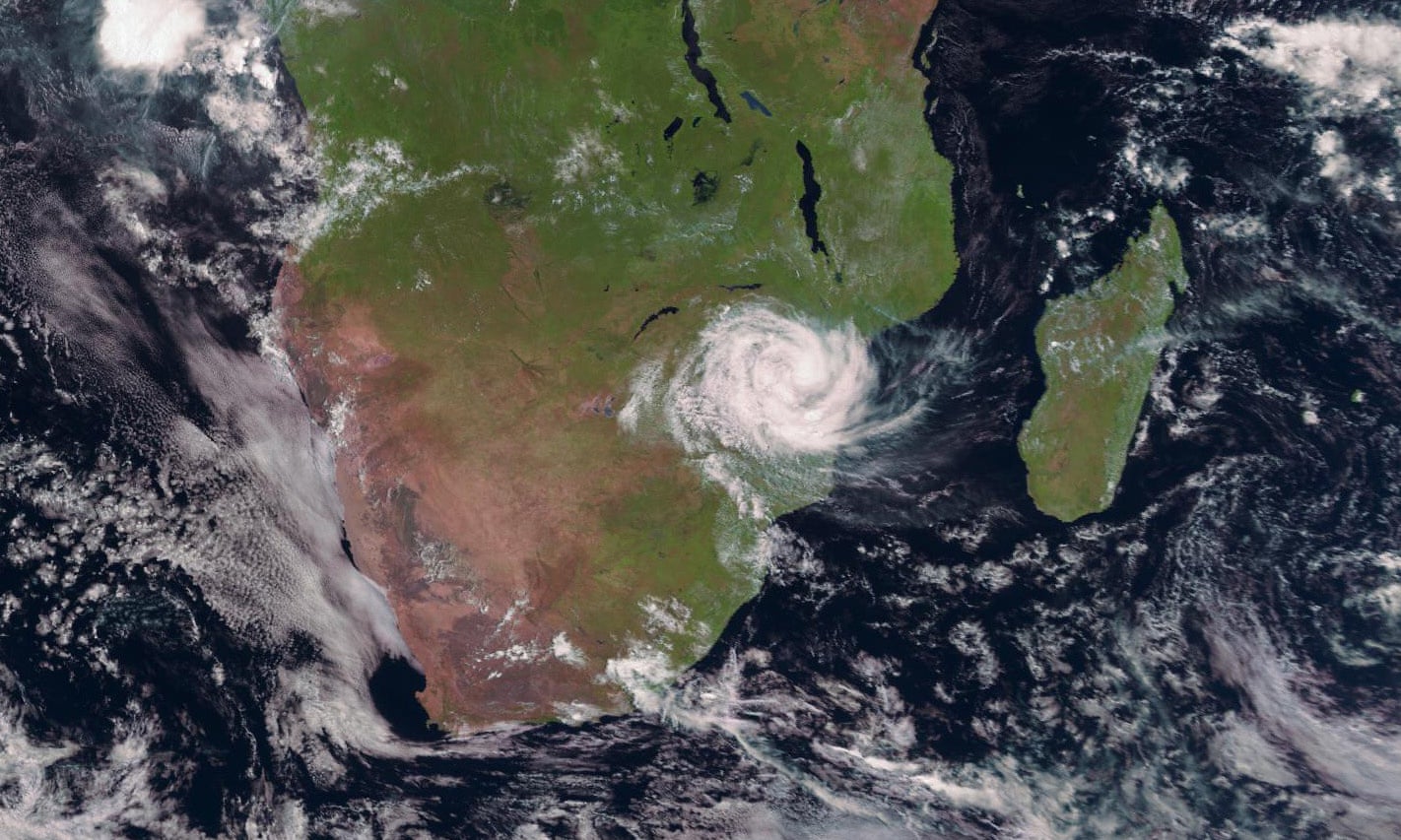
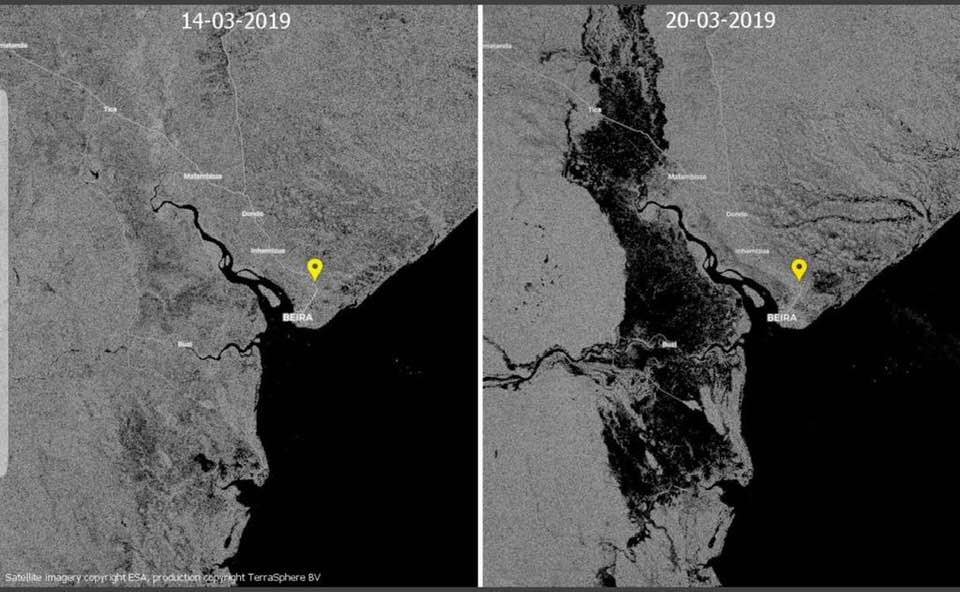
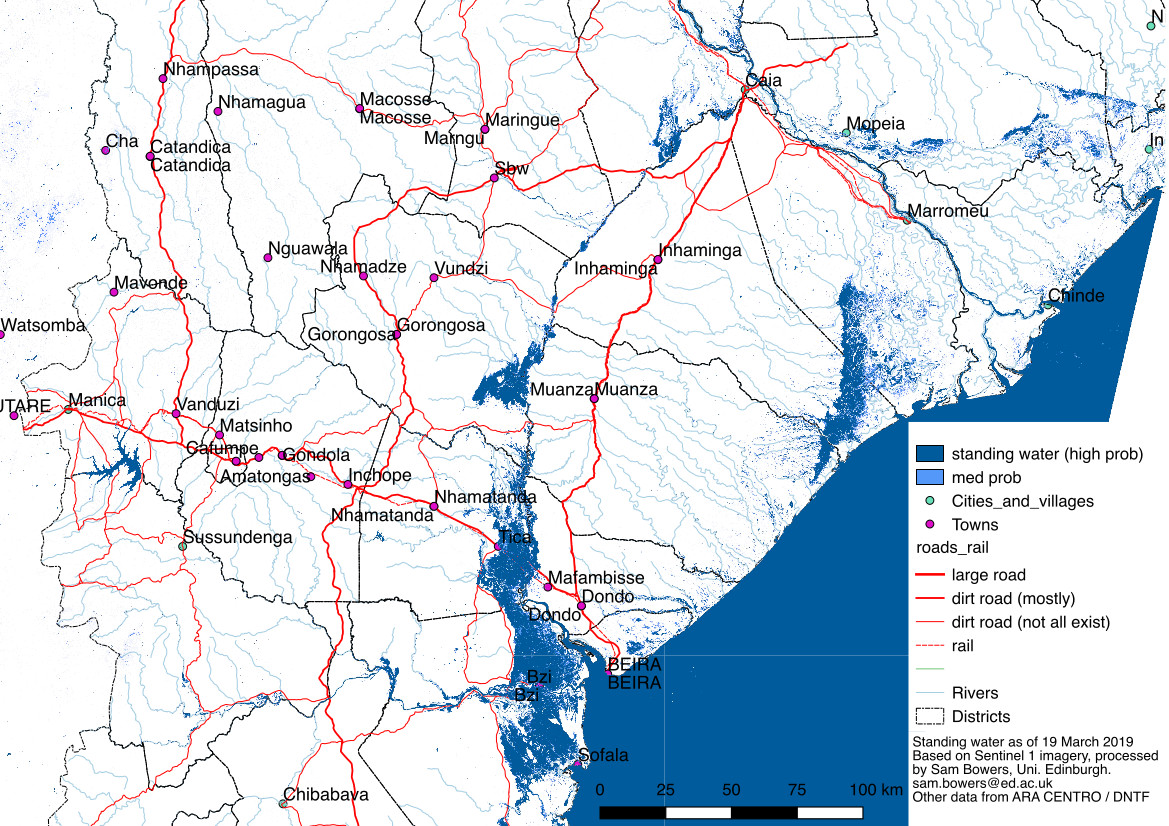
Updates
Briefing: The response to Cyclone Idai
New Humanitarian (formerly IRIN), March 21, 2019
http://tinyurl.com/y4lxkznr
Sumayya Ismail, Africa Editor
Vittoria Elliott, Freelance journalist
Nearly a week since Cyclone Idai struck three of the most
vulnerable countries in Southern Africa, needs are rising and
humanitarians still don’t have a full picture of the extent of the
disaster. Aid access is one of the biggest challenges and cholera
is a major concern.
More than a million people in Malawi, Mozambique, and Zimbabwe
have been affected by what the UN called a “massive disaster”. Its
emergency aid coordination body, OCHA, said “the situation is
likely to deteriorate, and the number of people affected is likely
to increase”.
Mozambique was the first country hit. Some reports estimate 90
percent of Beira, the fourth largest city, with more than 500,000
residents, may be damaged or destroyed. But Médecins Sans
Frontières said “it’s still too early” to have a complete overview
of the situation as many areas remain cut off and inaccessible by
road. Rain and heavy winds continue, so reaching certain areas by
air or sea is a challenge. The storm also destroyed most of
Beira’s telecoms infrastructure, making it difficult to get word
out of the affected areas.
“I am able to say that all health centres and hospitals have been
affected,” said Caroline Rose, MSF’s head of mission in
Mozambique, expressing concern about the growing health needs,
especially the risk of waterborne diseases, including cholera.
“Several health centres have lost their roofs and are in very,
very bad condition.”
In neighbouring Zimbabwe, “the situation we are seeing now isn’t
fully clear,” agreed Mildred Makore, Mercy Corps director of
programmes in the country. “Chimanimani, which is the worst-hit
district, is still inaccessible. Evaluations are going on… and we
may be overwhelmed when we have true access.”
Here’s a round-up of what we know about the humanitarian needs and
response.
What is the scale of the disaster?
Late on 14 March, Cyclone Idai made landfall off the coast of
Mozambique, before continuing to Zimbabwe and Malawi, causing
widespread devastation across parts of the three countries.
The scale of damage in Mozambique is “massive and horrifying”, the
International Federation of Red Cross and Red Crescent Societies
said. Tens of thousands lost their homes; roads, bridges, and
crops were washed away; and people remain trapped on roofs
awaiting rescue as parts of Beira are still under water.
More than 100,000 people needed emergency evacuation in Beira and
surrounding areas in Buzi District. Although the official death
toll is just over 200, Mozambique’s president estimated more than
1,000 people may have been killed. So far, 1,500 are injured and
17,000 displaced.
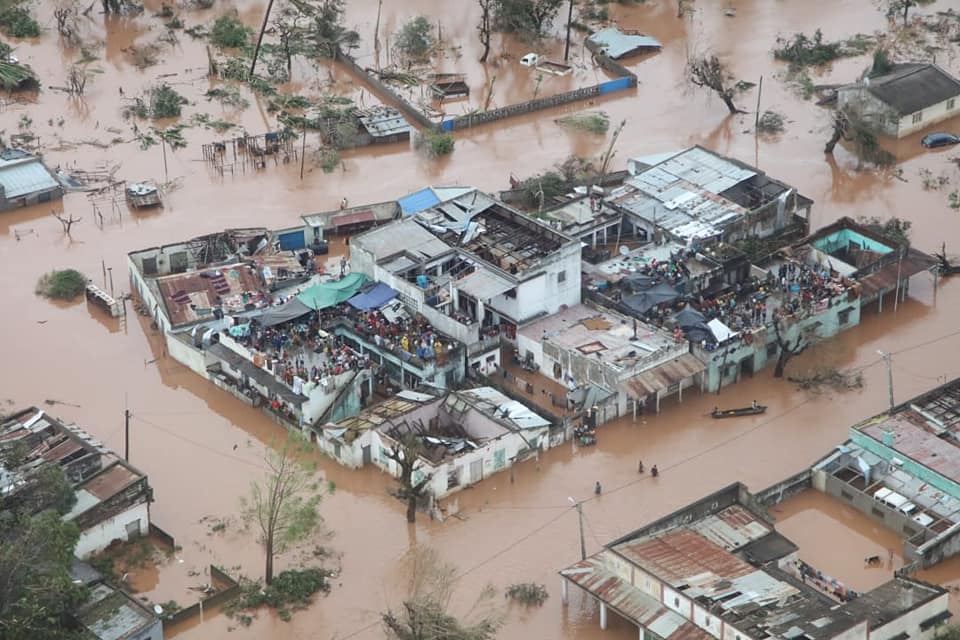
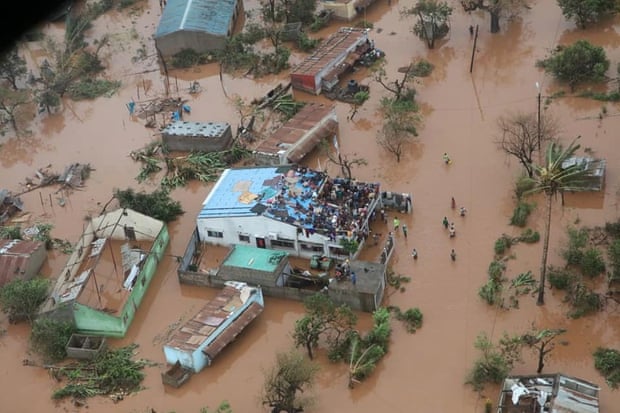
These photos from Buzi (above)were taken by Mozambique´s National
Institute of Disaster Management (INGC)
In Zimbabwe, floods destroyed 600 homes, affecting an estimated
15,000 people. So far, more than 100 people have been reported
dead, 200 are injured, and another 200 are still missing.
Malawi has reported 57 dead and more than 500 injured. More than
94,000 people are estimated to have been displaced and some
840,000 people have been affected, according to the government.
Although water levels have subsided a bit in Zimbabwe and Malawi,
flooding continues in Mozambique and hundreds of thousands remain
at risk. There are also growing concerns about the overflow of the
Marowanyati Dam in Zimbabwe, which threatens to increase water
levels in Mozambique.
Heavy rain and flooding before the cyclone hit had claimed more
than 120 lives and affected 1.5 million people in the region, the
UN said. Malawi and Mozambique are both prone to extreme weather
events, such as the floods that left hundreds dead in both
countries in 2015. While parts of Zimbabwe are under water, other
parts are in the midst of El Niño-induced drought, which has
caused a severe food crisis.
How were people impacted?
The World Food Programme estimates that 1.7 million people in
Mozambique alone were along the path of the cyclone when it hit.
MSF described the scene as “destruction – and a lot of water”,
saying that electricity, telecommunication lines, and main roads
leading into Beira remain cut off, with houses and buildings
submerged, and hospitals severely damaged.
Search and rescue operations are continuing, but many people
remain unreachable. Those who made it out of affected areas are
living informally in schools, churches, or sometimes just out in
the open, where they face the risk of respiratory infections and
other diseases. With people exposed to the elements “all the small
problems will become big problems”, MSF’s Rose said.
In Nsanje, one of Malawi’s worst-hit districts, “houses fell down
completely or partially, and a lot of toilets and kitchens went
down,” said Ilse Casteels, MSF’s head of mission in the country.
“Because of the floods people moved to higher areas, regrouping in
churches and centres and schools. For the moment there are a lot
of families staying there,” she said, even though some people have
returned home to start rebuilding as the flood waters recede.
In Malawi and Zimbabwe, people lost their homes but also their
livelihoods when the floods destroyed their crops. Many of those
affected in Zimbabwe’s eastern highlands are small-scale farmers,
Mercy Corps’ Makore said. As a result worsening food security will
be a major concern in the months ahead.
An estimated “200,000 are in need of urgent food assistance for
the next three months in Zimbabwe,” the WFP said, with Chimanimani
the hardest hit.
Who is responding?
UN agencies, local and international aid organisations, and
foreign countries have intervened or sent funds to assist the
humanitarian response. Many others are in the process of raising
donations.
The WFP aims to provide food assistance to some 600,000 people in
Mozambique and 650,000 people in Malawi. MSF is providing
emergency medical care in affected regions and, in Mozambique and
Malawi, it has prioritised continuity of care for vulnerable HIV
and tuberculosis patients who were being treated before the
disaster struck.
In Zimbabwe’s Chimanimani district, where severe flooding wiped
out roads and bridges and left the area accessible only by
helicopter, the International Rescue Committee has set up a mobile
clinic and is distributing food and specialised kits for women.
Mercy Corps has been focusing on water, hygiene, and sanitation
services.
In Mozambique, the Indian Navy and the South African Air Force
have been assisting the government’s search and rescue operation.
Meanwhile, aid organisations are estimating a long road to
recovery.
The World Health Organization is sending three months’ of supplies
for 10,000 people. CARE is working with the government of
Mozambique to provide seeds and livestock to replenish farms that
have been decimated by flooding.
The UN’s Central Emergency Response Fund, known as CERF, has
allocated $20 million to ramp up the humanitarian response across
the three countries. The UK is donating almost $24 million, the EU
close to $4 million, and the African Union $350,000. Tanzania said
it was sending urgent relief supplies, including tonnes of
medicine and food.
What are the humanitarian needs/gaps?
Access to potable drinking water, shelter, food, and healthcare
are the priorities, aid groups say, with water, sanitation, and
hygiene needs particularly urgent as the risk of waterborne
diseases is the major concern across the board.
“In Beira, we fear a huge cholera outbreak soon,” said MSF’s Rose.
“The main challenges will be [getting treatment] for people who
don’t understand they have cholera, and that it’s urgent, or
people who are not reachable, or people who cannot reach health
centres.”
Given that areas are still cut off, this is a real concern. To
mitigate the challenges, MSF will attempt a “decentralised system
with small cholera centres in many zones,” Rose said. “We cannot
ask people to go to big centres. We will have to be in the
communities where they are.”
Zimbabwe has been in the midst of a cholera outbreak since last
year. Mercy Corps, which has been assisting with the response, is
concerned that recent events will worsen the crisis.
“Our major concern is that the water bodies have been
contaminated, because the latrines have been destroyed,” Makore
said. “We are concerned because there can be an ensuing disaster
following that, related to the waterborne diseases,” including
cholera and typhoid, as well as malaria.
“We have to make sure the affected population has access to clean
water,” she said, adding that a lot more support is required to
help those affected in Zimbabwe - from immediate lifesaving aid to
longer-term support for communities who will need to rebuild.
In Malawi, MSF’s Casteels said the most urgent need is clean,
potable water, after many boreholes were affected by the flooding.
She also expressed concern about cholera and malaria spreading in
the coming weeks.
“The biggest concern that you hear is about food. Access to food
now, but also in the future. People are really afraid crops are
affected. And because the country is so dependent on agriculture,
that’s a big concern.”
What are the longer-term issues?
Mercy Corps’ Makore said the priority should be resiliencebuilding
for affected communities.
“Contextually, for Zimbabwe right now, we have got two natural
disasters at the same time. The El Niño-induced drought and now
this [flooding]... Whatever produce was available was washed away,
and livestock was also washed away,” she said.
“Right now, we need to speak about food security, which was
already an issue, but now we need to think beyond that because of
the potential for disease outbreaks, shelter concerns,
displacement. So I think we have a huge task ahead of us as
organisations.”
In Malawi, Casteels raised similar concerns. “The biggest concern
that you hear is about food,” she said. “Access to food now, but
also in the future. People are really afraid crops are affected.
And because the country is so dependent on agriculture, that’s a
big concern.”
Based on the aftermath of previous disasters that have affected
Mozambique, MSF’s Rose said: “it will take years to rebuild the
town [of Beira]”.
“This will have the worst impact on those most vulnerable,” she
said. “It’s those who have small, fragile houses that are worst
impacted, as they are always the people without the means to build
a new house. So it’s a vicious cycle. Those who have no means to
rebuild will be left outside with no house, more at risk of
disease and worse off."
"The situation is already complicated and it will continue to be,
especially for the most vulnerable,” she said.
In Zimbabwe, already confronted by a host of humanitarian,
economic, and political challenges, Cyclone Idai has only made the
outlook more bleak. “The priority is to help get people back on
track and restore some level of dignity and hope,” said Makore.
Additional update sources
Mwiza Munthali of AfricaNow! on WPFW, March 20, in Washington, DC
featuring Effects of Cyclone Idai on Southern Africa. Interviews
with Estacio Valoi, an investigative journalist based in
Mozambique and is part of Centre for Investigative Journalism
(CIJ); and Suzgo Khunga, an Assistant Bureau Chief and News
Analyst for Nation Media Group in Malawi. Hour-long radio program.
http://tinyurl.com/yxl9ll36
Guardian, “Cyclone Idai 'might be southern hemisphere's worst such
disaster' ,“ March 19, 2019
http://tinyurl.com/yycmjwut
NPR, “Plight Of Survivors After Cyclone Idai: No Power, No Homes,
No Roads,” March 20, 2019
http://tinyurl.com/y6n6nkmd
BBC, “Cyclone Idai: Mozambique survivors desperate for help,”
March 20, 2019
https://www.bbc.com/news/world-africa-47637166
BBC, “Cyclone Idai: How the storm tore into southern Africa,”
March 21, 2019
https://www.bbc.com/news/world-africa-47638696
Climate Change and Climate Justice
Two longer articles on the impact of climate change, in addition
to the two below, are:
Guardian, “Climate change making storms like Idai more severe, say
experts,” March 19, 2019
http://tinyurl.com/y669gnf6
BBC, “Cyclone Idai: What's the role of climate change?,” March 20,
2019
https://www.bbc.com/news/science-environment-47638588
++++++++++++++++++++++++++++++++++++++++++
Cyclone Idai: Time the Rich Countries Compensate Victims of
Climate Change Disasters
Centre for Natural Resource Governance, Harare, March 18, 2019
http://cnrgzim.org/ - Direct URL: http://tinyurl.com/y2f4k94r
Cyclone Idai is sweeping across Southern Africa with Mozambique
and Zimbabwe being the hardest hit. More than 200 people have died
across the region since the storm hit on 4 March. In Zimbabwe
Chimanimani district is the hardest hit, with more than 65 people
confirmed dead as of Sunday 17 March whilst hundreds are still
missing. Hundreds of homes were swept away whilst road
infrastructure was destroyed, rendering Chimanimani inaccessible
for rescue efforts.
Whilst human life is beyond monetary value, the loss in terms of
damage to property can reach billions of dollars, and some of the
families may never recover from their loss unless they are
properly compensated. And yet the big question is who must take
responsibility for compensating the affected people?
The link between extreme weather events and climate change can no
longer be disputed. Climate change, being a culmination of
unrelenting emission of greenhouse gases, mainly by the
industrialized rich countries, is responsible for the disaster
unfolding in Zimbabwe, Mozambique and Malawi – countries with
among the world’s lowest emissions rates.
However, whilst rich countries have enough resources to cushion
their populations from some of the extreme effects of climate
change, poor countries have limited resources to cope with climate
change-related disasters. Had there been enough adaptation
resources, a significant number of lives could have been saved.
Many were washed away whilst sleeping in their homes in the dead
of the night.
Whilst the benefits of greenhouse gas emissions are enjoyed by the
rich countries, the poor countries are on the receiving end of
deleterious effects of climate change. Sadly, given the reluctance
of rich countries to take drastic action towards carbon emission
reductions, natural disasters are set to increase resulting in
more loss of lives and property in the poor countries. Sadly
majority of the victims have no idea as to who is chiefly
responsible for their calamities.
The situation unfolding in our region is of global significance.
It is a consequence of human action and those contributing more to
climate change ought to compensate the victims.
The Centre for Natural Resource Governance is of the view that the
rich countries must pay their climate debt to the Zimbabwean
people – but the Zanu PF government and Minister Mthuli Ncube
cannot be trusted to manage the payments.
Instead, we need trusted agencies in civil society to receive aid
and direct transfers to the ordinary people affected. This could
be done simply by arranging payout systems in the affected parts
of Zimbabwe, so that everyone living in those areas would get a
reparations payment. There is need to compensate families for loss
of lives, destruction of homes and even loss of food, livestock
and domestic utensils. The situation is dire in fragile states
where governments have misplaced priorities which relegates human
security to humanitarian work of Non-Governmental Organisations
and well-wishers.
[For an additional article on the same theme, with multiple links
to related information, see “Cyclone Idai lays bare the
fundamental injustice of climate change,” Grist, March 19, 2019 (
http://tinyurl.com/y2voc543).]
+++++++++++++++++++++++++++++++++++++++++++++
Tropical cyclone Idai: The storm that knew no boundaries
The Conversation March 20, 2019
Jennifer Fitchett
Senior Lecturer in Physical Geography, University of the
Witwatersrand
https://allafrica.com/stories/201903200883.html
Tropical cyclone Idai has made headlines across southern Africa
throughout the month of March. Lingering in the Mozambique Channel
at tropical cyclone intensity for six days, the storm made
landfall in Beira, Mozambique in the middle of the month, then
tracked in a westerly direction until its dissipation.
The greatest impact of the storm was experienced on landfall. It
caused flooding, excessive wind-speed and storm surge damage in
the central region of Mozambique. Adjacent countries of Malawi and
Zimbabwe experienced severe rainfall, flooding and damage from the
high wind speed. Madagascar also experienced bouts of high
rainfall during the storm’s pathway to Beira.
The flooding has left hundreds of thousands of people homeless and
displaced across the region while the death toll has continued to
rise in the week following landfall. The effects of the cyclone
were felt as far south as South Africa and introduced rolling
blackouts due to damaged transmission lines that supply the
country with 1100 MW of power from Cahora Bassa in northern
Mozambique.
Historically, nine storms that had reached tropical cyclone
intensity made landfall on Mozambique. A larger number of weaker
tropical systems, including tropical storms and depressions affect
the region, with a total landfall of all tropical systems of 1.1
per annum.
The most severe tropical cyclone to make landfall in Mozambique
was tropical cyclone Eline in February 2000. It had a category 4
intensity on landfall and resulted in 150 deaths, 1000 casualties
from flooding, 300 000 people displaced and four ships sunk.
The storms off Africa’s east coast are weaker than their northern
hemisphere counterparts. Category 4 and 5 tropical cyclones make
landfall at a near-annual rate in the North Atlantic and North
Pacific.
Why the wide impact
Why have so many countries been affected?
Tropical cyclones are large storm systems. Immediately surrounding
the eye of the storm – a region of calm weather, no wind and no
rain – are spirals of storm clouds that span a minimum radius of
~100km. These cloud bands represent the thunder storm conditions,
with the rain and winds typical of a tropical cyclone.
A ~100km radius is typical of category 1 tropical cyclones, the
lowest intensity ones. As the storms intensify to categories 2, 3,
4 and 5, the size increases significantly. This means that a high
intensity storm, such as tropical cyclone Idai, has a range of
impact significantly larger than the storm track that it follows.
In recent years concerns have been growing about the impact of
climate change on cyclones. Research has shown that changes to the
world’s temperature, as well as ocean warming, are responsible for
an increase in the severity of tropical cyclones. This has
recently been researched for the South Indian Ocean. As the ocean
is warming, the region which experiences temperatures conducive to
tropical cyclone formation is expanding and temperatures in the
tropical regions are becoming warm enough for cyclone
intensification. Category 5 tropical cyclones, which have been
experienced in the North Atlantic for almost a century, started to
occur in the South Indian Ocean since 1994, and have occurred
increasingly frequently since then.
This means that as climate change continues and intensifies, so
too do these storms. This will mean a greater frequency of not
only severe damage from storms, but damage over a larger region.
In addition to the impact of warming on the storm intensity,
climate warming has also been found to increase the expanse of the
storms within any given intensity.
Cyclone Idai
So how intense was tropical cyclone Idai?
Storm track records, which include the geographic location of the
storm at set time intervals, the wind speed and the atmospheric
pressure, are documented by a number of regional climatological
organisations. This data is synthesised by the National
Oceanographic and Atmospheric Association, providing a useful
resource for scientists to explore storm behaviour.
Tropical cyclones are classified on the basis of their wind speed
and central pressure. The weakest storms to be classified as
tropical cyclones – category 1 – have a minimum sustained wind
speed of 119km/hr. At category 3 the storms have a minimum wind
speed of 178 km/h. As the category increases, so too does the
potential for damage. Category 1 storms are classified as
resulting in dangerous winds that cause some damage, whereas
category 3 storms are expected to cause devastating damage.
The history of tropical cyclone Idai is documented in these
records. The cyclone reached category 3 intensity between
03:00-06:00 on the 11th March 2019, while positioned at its most
easterly extent of the storm track. By 03:00 on the 12th March the
storm had dissipated to category 2 intensity, and it fluctuated
between intensities of categories 2 and 3 over the 36 hours that
followed.
From noon on the 13th March the storm maintained a category 3
intensity which persisted until landfall on the 14th.
What needs to be done
Storms that affect many countries present particular challenges.
They clearly have no regard for political boundaries. The fact
that they affect lots of countries presents challenges in both
preparing for storm events in a proactive way and responding to
prevent loss of life and livelihood. This requires countries to
communicate effectively with one another, to provide coherent
messages about the forecasting of the storm track and potential
damage, and to facilitate effective evacuations.
This storm provides a grim prospect of the future of tropical
cyclones in a region under continued threat from climate change.
Effective adaptation to minimise storm damage is essential in
preparing the region for an increase in the severity of these
storms. Disaster risk management plans are also very important to
minimise the loss of life.
AfricaFocus Bulletin is an independent electronic publication
providing reposted commentary and analysis on African issues, with
a particular focus on U.S. and international policies. AfricaFocus
Bulletin is edited by William Minter.
AfricaFocus Bulletin can be reached at africafocus@igc.org. Please
write to this address to suggest material for inclusion. For more
information about reposted material, please contact directly the
original source mentioned. For a full archive and other resources,
see http://www.africafocus.org
|
